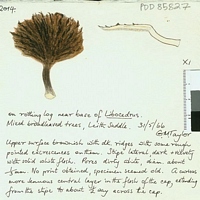|
 Polyporus xerophyllus Polyporus xerophyllus
SynonymsMicroporus xerophyllus
Polystictus xerophyllus
BiostatusPresent in region - Indigenous. Endemic
Images (click to enlarge)
Caption: Watercolour
Owner: G.M. Taylor |
Article: Cunningham, G.H. (1948). New Zealand Polyporaceae. 3. The genus Polyporus. New Zealand Department of Scientific and Industrial Research, Plant Diseases Division, Bulletin 74: 39 p.
Description: Hymenophore annual, solitary, firm, coriaceous, attached by a brief lateral stem. Pileus
reniform or fan-shaped, 1-2.5 cm. x 10-15 mm. x 1-1.5 mm.; surface reddish-brown, with
radiating black raised striae which are somewhat scabrid or ridged on the edges, cuticle
75-100 µ thick, of densely compacted pseudoparenchyma, arranged above into a palisade
with walls appreciably thickened and tinted brown; margin acute, concolorous, strongly
crenate and also toothed; hymenial surface cream when fresh, drying straw colour, even,
edged with a conspicuous shining black rounded sterile margin 0.5-1 mm. wide, dissepiments
not toothed; stem lateral, varying from a slight disc to a body 10 mm. long, 1-3 mm. thick,
solid, rugulose, black, attached to the substratum by a discoid expansion. Context 0.2-1 mm.
thick, white, becoming straw colour, firm, woven; skeletal hyphae 5-6 µ thick, lumen almost
obliterated, bovista type, freely branched, aseptate, staining; generative hyphae 3-5 µ thick,
thin-walled, branched, septate, with clamp connections, contents staining. Pores round or
angular, in section cream, to 1 mm. deep, 100-125 µ diameter, or 5-6 per mm.; dissepiments
50-100 µ thick, equal, thickened apically and delicately velutinate. Basidial type clavate,
basidia clavate, 12-16 x 5-6 µ, soon collapsing. Spores ovate or elliptic-oblong, 5-7 x 3.5-4 µ,
smooth, hyaline.
Habitat: Growing solitary on decaying stumps or dead branches, associated with a white
rot.
Distribution: New Zealand.
Notes: Differentiated by the small size of the fan-shaped pileus, lateral stem, strongly marked radiate
striae of the surface, palisade pseudoparenchymatous cuticle, and cream coloured hymenium.
In one specimen spores are definitely obovate, but in others they are both obovate and
elliptic-oblong.
|